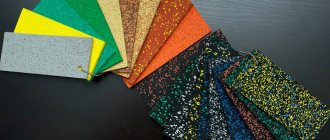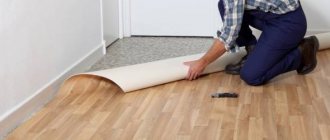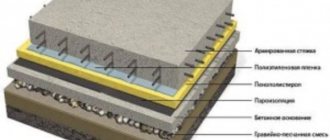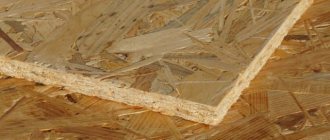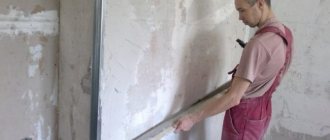Linoleum is a practical, convenient and inexpensive flooring option. But due to its elasticity, any unevenness in the floor surface becomes noticeable very quickly. This is not only unsightly, but also leads to faster wear of the material. That is why, with proper installation, the linoleum underlay is laid on a concrete floor.
Let's figure out why exactly a substrate is needed, what it is and in what types it is available. You will also learn how to properly lay it under linoleum on a concrete floor in an apartment yourself.
What is a backing and why use it?
The underlay for linoleum is a natural or artificial material that acts as a layer between the finished floor covering and the base on which it is laid. It differs in the raw materials from which it is made, the release form (rolls or sheets), size, density and other characteristics.
- The first and main role of the product is to level the base. Of course, we are not talking about using it to eliminate large potholes, bumps, or significant differences in height in different parts of the room. But it helps hide small flaws and irregularities perfectly.
- The next important function is insulation. Laying the underlay reduces heat loss in the room and helps partially absorb noise, both generated inside the room and penetrating from outside. Specific heat and sound insulation parameters depend on the material, density and size of the coating used.
- And finally, the last thing - the material helps to somewhat soften such hard bases as concrete. The floor will be slightly less hard, which will reduce the risk of injury or damage to things if you fall on it.
Substrate types
On the modern building materials market there is a wide variety of substrates that you can lay on a concrete floor with your own hands under linoleum. Let's talk in more detail about each of the types and illustrate them in the photo.
Please note: the type of underlayment affects how to properly lay it under linoleum on a concrete floor.
Jute
The material is made from natural fiber obtained by processing the stems of the same variety of herbs and shrubs. The use of jute for the manufacture of lining for floor coverings began relatively recently - previously it was used mainly only for the production of burlap and ropes.
The jute substrate has good sound and heat insulation characteristics, is highly environmentally friendly, and provides microventilation. The downside is the relatively high price - on average 100 rubles per square meter.
Just like any other natural materials, it is susceptible to rotting, destruction by fungi and insects. Impregnation with specialized chemicals reduces the vulnerability of the material, but not by 100%. Therefore, it is not recommended to lay jute products in rooms with high humidity.
Cork
This type of substrate is ground and compressed tree bark, usually cork or western oak, less commonly other plant species. To understand, stoppers for sealing bottles of alcohol are made from the same material.
The material is characterized by very low weight, high heat and sound insulation and minimal moisture conductivity. Among the disadvantages, the first thing to note is the high price - approximately 200 rubles per square meter or more.
An equally serious drawback is the excessive softness of the material. In a matter of days, in those places where there is at least some heavy furniture on the linoleum with such a backing, dents form. Even if the corresponding piece of furniture is removed or moved, these recesses will not completely straighten back out. So, cork covering under linoleum should be placed only in those rooms where there are no plans to install floor furniture at all or where there will only be, for example, light chairs and a table.
Combined
The material of such a substrate is a mixture of wool, jute and flax fibers, impregnated with binders. The advantages of the combined coating include good heat and sound insulation parameters, environmental friendliness, naturalness and durability. It is also quite dense and holds its shape well under load.
Cons - the material is vulnerable to moisture, easily allows water to pass through and absorbs it. Therefore, it is not advisable to use a combined underlay for laying under linoleum on a concrete floor in a damp climate or in rooms with high humidity.
Linen
The characteristics and appearance of such a substrate resemble jute, and is also made from natural plant materials, in this case, flax fibers. The material is lightweight, retains heat well in the room and insulates sounds. The cost of linen backing is also approximately the same as jute. The downside is that this coverage can be difficult to find. The volumes of domestic production of flax products and imports of flax products in our country are small.
Laying cork backing
How to properly lay cork underlayment under linoleum on a concrete floor:
- You must first prepare the base so that it is as clean and level as possible. First, you need to remove all large debris from the floor, vacuum it, and then level the surface so that fluctuations in its level are no more than 1-2 cm over the length of the room.
If the concrete floor in the apartment meets these criteria, then you can lay the underlay directly on it, as is. Otherwise, you should use specialized leveling mixtures based on cement or polymer materials.
- Also, before laying linoleum on a concrete floor and underlayment, you need to check the concrete for moisture. To do this you will need a small roll of cellophane. Place it directly on the floor, securing it with duct tape around the edges. After 10-12 hours there should be no drops on it. If they exist, then it is too early to carry out further work; the floor must be allowed to dry.
- It is also advisable to prepare the cork substrate itself in advance for the installation process. It's not difficult, just bring it into the room where it will be installed and leave it there for a few days. During this time, it will acquire the required humidity and temperature, which means it will lie much more evenly.
- Now all that remains is to distribute it evenly over the surface. Make sure that during this time the humidity in the room does not exceed 60 degrees and the temperature is 18 degrees Celsius or higher.
Now you can start the installation itself:
- Spread thin polyethylene on the floor so that it extends slightly onto the wall. Secure it to the wall with adhesive tape.
- If you are on the ground floor and there is some kind of unheated room directly below you, then you can lay a layer of waterproofing before laying the linoleum on the concrete floor. In all other situations, this is completely optional.
- If you purchased the material in the form of panels, then lay it out like a brick so that the joints do not overlap each other. After this, seal all seams with construction tape that does not allow liquid to pass through.
- If you are using a rolled version of the backing, then roll it out from wall to wall, cutting it end to end. Also connect parallel strips of material using construction tape.
- Remember to move as carefully as possible while laying the underlayment to avoid damaging it. The same can be said about linoleum itself.
Recommendations
Laying the substrate is a relatively simple process, but it also has its own characteristics. Before starting work, it is advisable to obtain at least a minimum of knowledge.
Basic recommendations from the experts:
- Before purchasing the material, do an elasticity test: if the substrate makes dents when compressed, most likely it will wrinkle significantly during use
- Concrete cannot be leveled with gypsum-based mixtures - in a damp room, the gypsum can peel off, and it will not withstand the optimal load
- For a smooth, cold floor, the underlay is needed as thermal insulation - when choosing, they focus on this property
- After pouring the screed, wait for the full period of concrete to gain strength (28 days), only then install the substrate
- Laying fiberglass in areas where there is a lot of foot traffic is contraindicated.
- Before installation, special attention should be paid to cleaning the base - remove all traces of detergents, dirt, oil stains
Laying felt, linen or jute underlays
All types of substrates made of soft, fabric-like material are laid in approximately the same way.
How to properly lay linoleum underlay on a concrete floor:
- The easiest way is to spread the canvas, wait about a day until it straightens and takes the shape of the floor, then trim off the excess around the perimeter of the room. After this, you can lay linoleum on top. This will be sufficient in most cases.
- But it is best not to just spread the canvas, but to glue it so that the flooring does not move during the process of laying linoleum. There are specialized adhesives that can be used, but if you don’t want to overpay, you can use regular PVA for gluing. It will be more than enough in most cases.
Even before laying linoleum on a concrete floor with a backing, in cold rooms it is recommended to add a layer of insulating material. If the rooms are warm, its installation is optional.
Please note: the polymer substrate is laid using the same technology. But if you do not plan to lay it without glue, it is better to purchase a special composition rather than PVA, because the latter is more suitable for wood or fabrics.
Adhesive for linoleum on concrete floors
Today you can find two types of adhesives in the store: mastic and special glue. The choice of one or another product depends not only on your preferences, but also on the type of coating with which you will be working.
Mastic
Manufacturers offer several options for mastic. A consultation with a specialist in the store will help you avoid mistakes in choosing; carefully read the instructions for using the product.
By the way, you can make mastic yourself. But, if construction experience is not enough, it is better not to take risks.
Glue
Dispersion adhesive is used in residential areas. It comes in three types:
- Bustilat is a universal adhesive, suitable for linoleum on a fleecy basis.
- Viscous acrylate contains resins. It is used for heterogeneous and homogeneous coatings based on synthetics, jute and fabric, as well as foam materials.
- Marmoleum and PVC on fabric and felt backing can be fixed using humilax - glue with latex and acrylic.
However, this division is conditional. Manufacturers specify the types of decking that can be bonded with a specific product.
Reaction glue, although it is strong, durable and elastic, has a pungent odor. Therefore, it is used in commercial construction.
- Floor
We solve a difficult problem: how to lay linoleum in a room with furniture
Laying plywood underlay
A slightly different approach is used when you are laying a hard underlayment, such as plywood.
How to properly lay plywood under linoleum on a concrete floor:
First you need to put the base in order. If it is uneven or inclined, then you need to level it with special mixtures.
- If there is a wooden covering on top of the concrete, it is worth dismantling it (or at least removing the problematic floorboards and fixing the problem). In some cases, plywood is laid on specially prepared joists or anchors, but these are special cases.
- Next you need to prepare the plywood sheets. They should be either square with a side of 60 cm or rectangular.
- First, draw up a diagram of their installation (you can simply draw it on a piece of paper), and then proceed from this when cutting the plywood. Please note that it is advisable to cover the entire floor area with sheets of equal size. Narrow rectangles are only permissible at the beginning of the row, because the load there will be comparatively less.
Advice! Before cutting, let the plywood lie for a couple of days in the room where you will lay the linoleum, then it will adapt in terms of humidity and temperature.
Be sure to also sand the sheets to remove any unevenness and treat them with a water-repellent compound before laying the linoleum on the concrete floor.
When laying, be aware that a sheet of plywood will lag behind the wall by about a centimeter, from another sheet - by about 4 mm, and the offset of the sheets in different rows will be approximately 30 centimeters relative to each other.
How to lay a linoleum backing on concrete:
- First, you lay the prepared sheet and align it with the wall, leaving the desired gap.
- Then the holes for the fasteners are countersinked, the sheet is fixed with self-tapping screws with a stroke of approximately 20 centimeters. The hats must be recessed, otherwise you will damage the linoleum.
- The next row is laid with a gap. The process continues until the entire row is recorded.
- The next row begins with a shorter rectangular sheet to allow for the desired offset.
- When the rows are laid out and fixed, you need to go through all the sheets and check the quality of their fastening. Then you need to thoroughly clean the seams and surface of the sheets from shavings and dust.
Please note: plywood can be laid on the floor without glue if it is secured with a sufficient number of screws.
Some useful tips
To properly install underlayment and linoleum, follow some important guidelines.
- When buying a substrate, check it for rigidity - press on it, and if dents eventually appear on it, then it is better to refuse the purchase. Give preference to quality products from trusted manufacturers.
- Do not level the floor with gypsum putty, as it will quickly peel off in high humidity. Also, plaster will not withstand the loads from massive furniture.
- After filling the screed, wait 28-30 days for it to dry thoroughly, and only then proceed to further work.
- Remove traces of detergents (if any) remaining after preparing the base.
You need to do the work slowly and according to technology, so as not to be upset later due to defects that appear
Prices for IVC linoleum
Linoleum IVC
Prices
The cost of underlayment for a linoleum floor on a concrete floor can vary greatly depending on what materials are used, what brands they are made of, what the thickness of the product is, and so on. Therefore, the prices given below should be taken solely as indicative for an approximate understanding of the costs of this item of repair work.
- Cork backing - price per 1 square meter varies from 150 rubles to 2000 rubles.
- Felt - the price per 1 square meter varies from 300 rubles to 500 rubles.
- Linen - the price per 1 square meter is around 150–200 rubles.
- Polyethylene - the price per 1 square meter is around 15 rubles.
- Jute - the price per 1 square meter is around 150–200 rubles.
- Plywood backing - price per 1 square meter varies from 200 rubles to 1000 rubles.
Advice: buy material not exactly close to the required quantity, but with a small margin.
How to determine the thickness of the material
The peculiarity of the installation of various products lies in the requirement for the base. For all types of materials, the room must be kept clean and dry when laying. It is necessary to empty the room of furniture and dismantle the baseboards.
The wooden base should be treated with a primer with an antiseptic; visible damage to the boards and seams should be repaired with wood putty. Then the selected type of substrate is laid. A roll lining made of natural raw materials is fixed with the staples of a construction stapler.
If you decide to lay sheets of chipboard, OSB or plywood, you need to calculate the required material. Then the frame is assembled. The joists are attached to the floor with screws and self-tapping screws. The slabs are laid so that the joints are staggered. The sheets are screwed to the frame with self-tapping screws.
Installation of hardboard fiberboard is carried out using wood screws or nails without installing a frame.
Cork flooring requires a level base, so the flooring is initially leveled. Cork rolls should lie in the apartment for a couple of days so that the temperature and humidity of the substrate are equalized.
Waterproofing must be laid on the concrete screed (usually polyethylene is used) when there is an unheated basement below the room. Then the rolled cork backing is rolled out, and the strips are fixed together with construction tape. To prevent damage to the cork, installation and subsequent installation of linoleum is carried out carefully and with care.
The concrete base is leveled with a cement screed or self-leveling floor (with minor differences in height). Before applying the sand-cement mortar, the surface is treated with a primer. How long the screed takes to dry depends on the ambient temperature and humidity; in warm weather, you need to ventilate the room more often. The underlay should be laid after the floor has completely dried.
Penofol is spread with the foil facing up, the joints between the rows are sealed with foil tape.
Installing a rod-type infrared floor is too labor-intensive to install, so it is easier to choose a film version of a heated floor. You should not place thermal film under furniture, since infrared radiation heats surrounding objects. The thermo-reflective bedding is laid out and secured with tape. Then the IR film is spread out, connected into a circuit with clips, and the wiring is connected to the thermostat and temperature sensor. Floors can be grounded.
IMPORTANT: The underlay should be used regardless of whether the linoleum has a base or not. It not only increases heat and sound insulation and levels out minor unevenness in the base. But it also acts as protection against contact with the base.
In concrete foundations, after the screed has fully matured, moisture remains. Its emission varies depending on air humidity, temperature and even atmospheric pressure. Linoleum, even on a special basis, will take on this destructive effect. To minimize it, the substrate protrudes. But when using substrates made of natural material, it is necessary to organize waterproofing using a thick polyethylene film.
Temperature fluctuations lead to changes in the geometric dimensions of the room. And with concrete, the coefficient of thermal expansion is much more noticeable than with linoleum. In this case, the substrate takes the main blow.
The passage of thermal and sound waves through dense materials is described in detail in the Debye model. To reduce heat loss and increase sound insulation, it is necessary to create a “layer cake” on the floor. In this case, the substrate helps out.
READ MORE: How to use an old bathtub in the country? 39 photos Ideas on what you can do with your own hands for a summer cottage using a bathtub? What can you plant?
Please note that when organizing sound insulation, a very curious phenomenon occurs. If it is organized incorrectly, you can achieve an effect where your neighbors can hear you, but you cannot hear them. In fact, you seem to be comfortable in silence, but the awareness of the fact that they hear you will not allow you to calm down. It is the substrate that eliminates such an incident.
On a wooden base, all of the above factors appear to a lesser extent, but they are present. They are also leveled using a substrate.
This parameter is very important when laying soft floor coverings. There is a simple rule: the thickness of the substrate should not exceed the thickness of the linoleum.
Ideally, these parameters should match.
What kind of underlay to lay?
Another important component of the topic: which substrate to choose from all their variety. There is no clear answer to the question which one is better; it all depends on the situation.
Laying linoleum on a concrete floor if the quality of the latter is poor should ideally begin with the installation of sheets of plywood or similar material. And only then you can lay a thin layer of fabric or polyethylene backing.
In damp rooms, linoleum flooring will generally not be the most optimal solution; tiles will be much better. But if you choose just such a floor covering, then it is better to put polyethylene under it, as the most moisture-resistant material.
For dry rooms with a smooth, good subfloor, there are no clear criteria for how to choose what to lay under linoleum on concrete. You should be guided by personal preferences. You also need to remember that felt and cork products leave marks from the furniture.
A separate case is linoleum with a backing. Typically, a soft non-woven layer 1-2 cm thick is attached to this type of floor covering, which resembles the feel of dense felt, made of synthetic or natural fibers.
Is there a need for a linoleum underlay on a concrete floor in this case? Definitely not, if the coating is laid on a fairly flat base, and there is no need for additional straightening. The lining layer will “eat up” the extra few centimeters of room height, but will not provide any benefits.
Coating features
Everyone strives to make their home cozy and comfortable. Each room of an apartment or house corresponds to its purpose and method of use. Therefore, you need to choose a floor covering for the room that suits its purpose. Popular floor coverings are linoleum and carpet.
In the bedroom and living room, when you want softness, comfort, and a warm atmosphere, you should think about carpet. It is distinguished by comfort and convenience. A carpet is similar to a rug or rug, but it geographically occupies the entire area of the room. The main feature of carpet is its household and hygienic disadvantages. It needs careful care and cleaning so as not to become a breeding ground for bacteria, fungus, dirt and mites.
Linoleum has long been a favorite method of flooring. It received its recognition for its positive qualities: durability, ease of care, quick installation, moisture resistance, variety in the choice of colors and patterns. High-quality and wear-resistant types of linoleum can replace tiles, laminate, and parquet. It is laid in kitchens, hallways and other rooms where quick floor cleaning is needed.
The main disadvantage of this coating is that it is a synthetic material and it gives off a feeling of cold. The last disadvantage can be dealt with using a substrate.
Linoleum is divided into: baseless, foamed, warm base. A warm thick base made of felt or jute has shock-absorbing and heat-insulating properties and does not require additional support. A thin product will highlight all the features of the floor; in this case, a lining is necessary.
Summary
Underlay is a synthetic or natural material that is used when laying linoleum on a concrete floor. It evens out minor differences in the height of the base and contributes to better thermal and sound insulation of the room. The material is made from wood, polyethylene, plant fibers, and recycled wool. The choice of the appropriate product option will vary depending on the type of room. How to properly lay it under linoleum on a concrete floor depends on the type of substrate.
Functions
Linoleum underlay is used to mask minor irregularities, dents, and cracks in the flooring. If the surface is slightly uneven, and there is no time or opportunity to level the floor, then the underlay will be a suitable solution to solve the problem. If you lay a gasket, it will help to visually make the floor even, especially with thin linoleum.
To protect the outer covering from dampness, the cold of the concrete screed and unheated rooms of the lower level, an insulating bedding is placed. It will cope with humidity and keep the room warm. The backing serves to protect the linoleum from premature wear.
